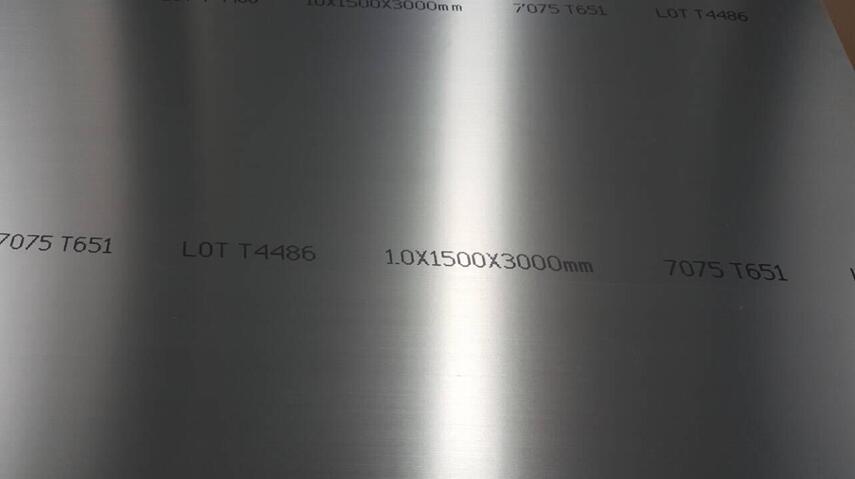Aerospace grade 7000 series aluminum (Al Zn mg Cu system) is the main structural material of aerospace because of its low density and high strength. Recently, with the requirement of automobile lightweight, more and more automobile enterprises begin to use it to reduce weight, especially the electric vehicle. For example, about 97% aluminum alloy is used in the car body of Weilai, including 7003 high-strength aluminum alloy developed by Chalco, which plays the purpose of safety and weight reduction.
Aerospace grade 7000 series aluminum is becoming one of the hot spots in the development of lightweight structural materials in the world. By optimizing the alloy composition, adopting advanced blank making method, forming process and heat treatment process, researchers developed high-strength aluminum alloy with better performance: high strength (yield strength higher than 600 MPa), higher toughness and corrosion resistance, and lower cost.
In the middle of the 20th century, 7075 and B95 high-strength aluminum alloys were developed by adding Mn, Cr, Ti and other alloy elements to the Al Zn mg Cu alloy to improve SCC resistance. In 1972, Alcoa developed 7050 aluminum alloy by reducing the content of Fe and Si impurities and replacing CR with Zr. After 1970s, developed countries concentrated on two aspects of research: 1. Developing heat treatment, such as 7150-t77 alloy of Alcoa in the late 1980s; 2. Developing RS / PM process of rapid solidification / powder metallurgy, such as 700MPa high-strength aluminum alloy with tensile strength developed in Japan in 1992.
Alloying
The main alloy elements of
aerospace grade 7000 series aluminum are Zn, Mg, Cu, Zr and impurity elements Fe, Si. M (Zn)% is 7% - 12%, m (mg)% is 2% - 3%. The main strengthening phases of Zn and Mg are mgzn2. The increase of Zn and Mg content will increase the strength of the alloy, but decrease the toughness and SCC.
m (Cu)% is about 2% - 3%. Cu can improve the strength, plasticity and SCC of the alloy. The reason is that Cu atoms enter GP region and delay aging precipitation. Cu atoms decrease the potential difference between grain boundary and in crystal, and increase SCC.
m (Zr)% is about 0.05% - 0.15%. Zr can also improve the strength, toughness and SCC of the alloy. The reason is that Al3Zr has two kinds of structures: tetragonal structure precipitated from the melt, refining the grains; spherical structure precipitated from homogenization, CO lattice with the matrix, inhibiting recrystallization in heat treatment.
M% of Fe and Si is less than 0.1%. They are harmful elements that reduce the fracture toughness of the alloy. The reason is the formation of alfesi brittle phase, in the plastic deformation of the matrix and brittle phase deformation is not coordinated and the formation of small cracks.
Microstructure of
aerospace grade 7000 series aluminum
The precipitation sequence of Al Zn mg Cu alloy is alpha (supersaturated solid solution) - GP region transition phase (mgzn2) - equilibrium phase (mgzn2). Among them, the factors that determine the properties of the alloy include: GP region, the size, quantity, distribution of transition phase and equilibrium phase, and PFZ. It is found that when the GP region is dominant, the strength of matrix precipitate phase is low, dislocations can shear precipitates and form slip bands, which cause dislocations to accumulate at the grain boundary and generate large local stress, so SCC and toughness are reduced; but when the transition phase is dominant, its strength is high, and dislocations pass through the precipitate point by Orowan mechanism. The uniformly distributed transition phase hinders the dislocation movement and is not easy to cause the stress concentration. At the same time, it hinders the hydrogen atom to gather to the grain boundary and improves the SCC and toughness. To sum up, the well distributed fine dispersion transition phase is better. In addition, the precipitates on the grain boundary are coarse and incoherent particles with discontinuous distribution, which can improve SCC and toughness. Finally, reducing or eliminating PFZ can improve SCC and toughness.
Heat treatment
Heat treatment of
aerospace grade 7000 series aluminum includes homogenization, solution quenching and aging process. Among them, aging has the greatest impact on the performance. There are three common aging processes: peak aging, overaging and regression reaging (RRA).
The peak aging is one-step aging. The fine and semi coherent dispersed phases (dispersoids) are precipitated in the crystal, and the continuous particles with coarser grain boundary are distributed. This aging feature is high strength but poor SCC.
Over aging is a two-step aging. The first stage is low temperature aging for nucleation; the second stage is high temperature aging for stability. After over aging, the grain boundary is distributed with intermittent coarse particles. The aging characteristic is that the strength of the alloy decreases about 10%, but SCC is good.
The RRA treatment is three-step aging. The first stage is the lower temperature; the second stage is the short time regression treatment at higher temperature, and there are intermittent coarse particles on the grain boundary, but the dissolution of the transition phase in the crystal decreases the strength of the alloy; the third pole is the lower temperature, and the fine semi dispersed phase is dispersed in the crystal, and the grain boundary is still intermittent non coherent phase. Therefore, RRA combines the advantages of peak value and over aging, resulting in high strength and good SCC.
summary
Aerospace grade 7000 series aluminum is an important lightweight and high strength structural material. How to develop a higher strength aluminum alloy to replace the traditional steel to achieve the purpose of electric vehicle safety and weight reduction is becoming one of the hot spots. Current and future research includes: 1. Optimizing alloy elements; 2. Optimizing metallurgical process; 3. Optimizing aging process; 4. Studying and establishing aging, stress corrosion and fracture toughness models to predict alloy properties.






